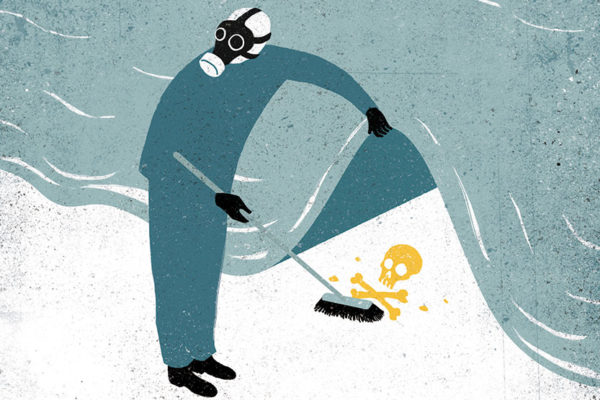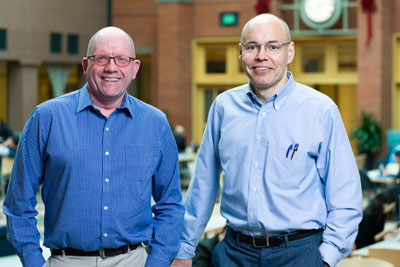The Clean Get Cleaner

As more information about toxic chemical releases have become public, the environmental improvements linked to these disclosures have disproportionately benefited wealthy communities.
There’s no question that shining a light on companies’ dirtiest deeds has encouraged them to clean up their act. Thanks to required environmental disclosures during the past three decades, toxic emissions from corporations have dropped by more than 31 percent across the country.
But this simple success story holds a more worrying trend, according to new research by Arturs Kalnins, associate professor of strategy at the Peter and Stephanie Nolan School of Hotel Administration, and Glen Dowell, associate professor of management and organizations at the Samuel Curtis Johnson Graduate School of Management. The benefits of our cleaner country have accrued primarily to the wealthiest quartile of communities, while the poorest quartile — though still better off than they were in the 1980s — has improved at a far slower rate.
Kalnins and Dowell went into the research believing that the opposite might be true. Decades of research have shown that environmental burdens are more likely to be shouldered by socioeconomically disadvantaged communities. This might seem to suggest that the lowest-hanging fruit for cleaning up was in these same lower-income communities. “My initial thought was that if pollution has been declining, maybe that’s also helping the inequality aspect of it,” says Kalnins.
The pair were particularly interested in the ways that public information alone might nudge corporations to take action or for communities to demand it. Were public disclosures — without regulations accompanying them — enough to lead to significant improvements?

Kalnins and Dowell had a readymade opportunity to study this idea through the Toxics Release Inventory (TRI), a program that requires facilities to report on their use and disposal of toxic chemicals. The TRI, first released through the Environmental Protection Agency in 1987 and now reported annually, was created after it became clear that some companies were producing and emitting harmful chemicals into their communities without residents’ knowledge. Although the TRI was not designed to regulate any emissions, it did illuminate areas of concern. The public reports allowed community members to track the biggest polluters and monitor their progress over time.
To find out more about the impact that the disclosures were having, Kalnins and Dowell combed through more than 25 years of TRI reports detailing the release of hundreds of airborne and waterborne toxic chemicals by thousands of companies. They then overlaid this information with county-by-county United States Census Bureau data on income, the proportion of minority residents, and education levels.
The clearest dividing lines occurred at different income levels. In the poorest quartile of communities, for example, corporations emitted 10.5 billion pounds of chemicals into the environment between 1987 and 1999. That number had dropped to 8.6 billion pounds between 2000 and 2012, an overall improvement of 18 percent. By contrast, corporations emitted just 2.9 billion pounds of pollutants into the wealthiest quartile of communities between 1987 and 1999. Those emissions dropped to under a billion pounds between 2000 and 2012. The total improvement for these communities was nearly 68 percent.
In other words, the richest communities — already far cleaner than their poorer counterparts — continued to widen the emissions gap during the past 30 years. Decades ago, the richest communities were about three and a half times cleaner than poorer ones in raw numbers; now they’re more than eight times cleaner. Because these emissions are all linked to human health concerns, these poorer communities will also likely experience disproportionate health impacts as well.
“In richer communities, residents can put more pressure on companies to clean up.” — Glen Dowell
While Dowell is quick to praise the overall decline in toxic emissions countrywide, he says the results also highlight a more complicated problem. “These [results] really ask policy makers and the managers of corporations to think about what this means as we lean more on information disclosure as a form of regulation,” he says. “For example, this form of regulation may have greater benefits for people who have the full capacity to deal with more information. In richer communities, residents can put more pressure on companies to clean up. They may be less afraid of losing [a polluting company] because they have the resources to move or to get another job.”
Indeed, says Kalnins, the Flint water crisis, which came to light just as the pair were putting the finishing touches on their study, seemed to provide a vivid illustration of the challenges that poor communities face as they seek cleaner and safer living conditions. “While [the Flint crisis was caused by neglect] from the government, not a corporation, it illustrated how lower-income communities don’t always have the resources to push back effectively,” he says.
“Lower-income communities don’t always have the resources to push back effectively.” — Arturs Kalnins
If the news for lower-income communities is mostly grim, that’s not to say that there aren’t bright spots tucked within the data. While most states saw similar links between income and emissions changes, California and Massachusetts were outliers. In these two states, both low- and high-income communities saw dramatic pollution decreases of roughly the same magnitude. In California, low-income communities saw an emissions drop of 69 percent while high-income communities had a 75 percent drop. Numbers in Massachusetts were 66 and 70 percent, respectively.
For Dowell, these numbers suggest that equity is possible for other states that want to make both aggressive and equitable improvements. “These are two states that have progressive environmental policies, and it’s clear that in these cases, the poorest communities are not falling behind,” he says. They provide a striking contrast — and perhaps a model to follow — for the seven states whose poorest communities actually saw worsening pollutant levels over time.
As Kalnins and Dowell look ahead, they see numerous worthwhile areas for future study. This may include looking at whether or not companies are shifting their most emissions-heavy activities to low-income areas and what kinds of companies are likely to be the biggest polluters in these areas.
For now, says Dowell, the clearest lesson is that information disclosure is just one part of a comprehensive and effective approach to a cleaner and healthier community. “Information disclosure by itself won’t necessarily bring us all the way to the outcomes we want,” he says. “It makes a difference, but it needs to be catalyzed by other things.”
Illustration credit: theispot.com/Davide Bonazzi

Comments